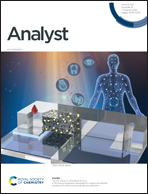A 3D porous graphene aerogel@GOx based microfluidic biosensor for electrochemical glucose detection†
Abstract
As a chronic disease, diabetes may result in serious complications that endanger the health and life of patients. Accurate and real-time detection of blood sugar levels is of great significance for the prevention and treatment of diabetes. In this paper, an enzymatic electrochemical microfluidic biosensor for glucose detection was developed based on a three-dimensional (3D) porous graphene aerogel and glucose oxidase (GOx). A graphene aerogel was prepared by freeze-drying a graphene hydrogel and has a high electrical conductivity, the 3D porous structure provided a good near-biological condition for GOx and the increased specific surface area allowed more GOx to be immobilized on the graphene aerogel. The microfluidic system greatly reduced the consumption of samples during tests. Amperometric measurements were carried out to test glucose concentrations, and the enzyme biosensor showed a linear range from 1 mM to 18 mM (R2 = 0.991). The limit of detection (LOD) was 0.87 mM (S/N = 3) and the sensor showed excellent selectivity and stability. Finally, monitoring glucose in serum samples was achieved by the proposed sensor and good recoveries were obtained. Due to its excellent performance, the proposed biosensor has a favorable application prospect in the prevention and clinical diagnosis of diabetes. Furthermore, our method, which is used to prepare a graphene aerogel modified electrode in a microfluidic chip, can be widely used in various electrochemical sensors.



 Please wait while we load your content...
Please wait while we load your content...